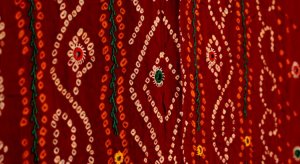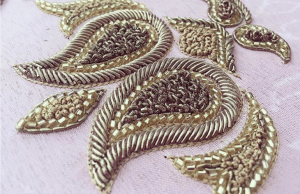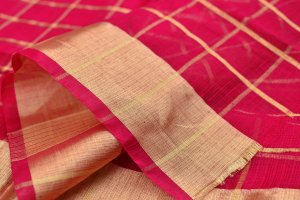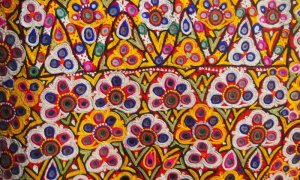Rajasthani Handicrafts
We have always known Rajasthan for its vibrant culture and soothing folklore. But Rajasthan is more famous for its majestic forts and detailed artwork. Exploring the handicrafts of Rajasthan, let’s have a look at their textile handicraft. Rajasthani textile is close towards its traditional roots. The technique, even though centuries old, is still relevant and “in-vogue”.
Rajasthani Handicrafts Ajrak Printing

Ajrak printing is a type of printing technique that is quite famous in Rajasthani region. It is a distinguished type of woodblock printing, thus different from known techniques of woodblock printing. The word Ajrak is derived from the Arabic word “Azrak” which simply means indigo.
The connection between Ajrak printing and indigo is the Sindhi community, which was initially known for its indigo production. Thus, this type of textile material is mainly seen in the Sindhi community. The most common motifs that Ajrak printing uses is of nature like the sun, moon and stars. The main feature of this type of textile designing is its sustainability; because it uses only a few natural resources for production.
Rajasthani Handicrafts Bandhej or Bandhani

The most famous type of clothing coming from Rajasthan is Bandhej or Bandhani. Bandhej is derived from Sanskrit word banda meaning “to tie”. Thus, Bandhej is an art of tying the fabric at several points.
This is the oldest form of “tie and dye” art, and its proved by the visual representation seen in Ajanta Caves. The highlight of Bandhej is its vibrant use of colours, and a variety of designs and patterns.
Even Though there are a variety of symbols that are used in Bandhej, the most common ones are dots, waves, stripes and squares. The designs that are often seen are Ekadali (single knot), Trikunti (three knots), Chaubandi (four knots),
Dungar Shahi (mountain pattern), Boond (small dot with the dark centre) and Kodi (teardrop-shaped). The variety of patterns available in Bandhani is the most dynamic part of it, some of the examples are Lehriya, Mothra and Shikari. The range of vibrant colours available in Bandhej transit a different meaning.
Rajasthani Handicrafts Dabka Embroidery

Bandhej is still on-trend, but a unique type of technique that got buried with other such artistic technique is Dabka embroidery. Dabka embroidery involves detailed patterns with a spiral wire which looks a lot like a spring.
The spring is usually made of metal, and the process of tightly tying this coiled metal on a piece of fabric is called Dabka. Dabka is well-known for its detailed oriented embroidery and has a 3D appearance.
The motifs common in Dabka is aligned towards nature like flowers, leaves and birds. Nowadays, the traditional Dabka look is somewhat disappearing but it is seen modern couture especially in the clothing line by Gaurav Gupta.
Rajasthani Handicrafts Kota Doria

Kota Doria is a distinctive woven fabric with a square-checked pattern. Kota Doria, as the name suggests, comes from the town of Kota situated in Rajasthan.
Kota Doria is a technique that is mainly used by groups in Kota to make sarees. Although the sarees in Rajasthan are made with heavy yarn count, Kota Doria is known for its low yarn count.
The peculiar square-checked pattern comes in a variety of sizes and colours.
Rajasthani Handicrafts Sheesha Embroidery
The most captivating handicraft coming from Rajasthan has to be, Mirror work or Sheesha embroidery. The mirror that is used in this technique of embroidery varies in shapes and sizes.
There are many shapes like squares, hearts and so on that these mirrors are cut in. The cutwork of mirror is done with one of the three methods which are hand blown glass (traditional method of tailored cutting glass), machine-cut glass and sheesha embroidery (mirror, as well as embellishments, are used).
We can see the vivid explosion of colours in Rajasthani cloth work, just like their vibrant culture. These designs and patterns can make your traditional look more striking in the whole room. You can also turn these traditional look into your everyday look with a fusion of western wear.






